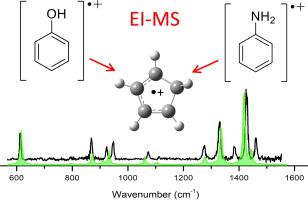Journal of Molecular Spectroscopy ( IF 1.4 ) Pub Date : 2021-04-08 , DOI: 10.1016/j.jms.2021.111453 Dennis Zeh , Marcel Bast , Daniël B. Rap , Philipp C. Schmid , Sven Thorwirth , Sandra Brünken , Stephan Schlemmer , Mathias Schäfer

|
Molecular ions of phenol and aniline as well as the fragment ion at m/z 66 formed by electron ionization are examined with cryogenic messenger-IR ion spectroscopy and theory. According to the recorded IR spectra aromatic ground state molecular ions of phenol and aniline are clearly identified. Similar to earlier reports our new set of spectroscopic and computational results supports the assumption that tautomeric molecular ions of phenol and aniline are only short-lived intermediates in the reaction path to the ultimate CO loss reaction product of phenol as well as the HNC loss product of aniline. Even the present cryogenic messenger-IR ion spectroscopy approach failed to collect spectroscopic evidence of the intermediate presence of these elusive tautomers of phenol and aniline molecular ions. However, our study clearly shows that the electron ionization mass spectrometry dissociation product ion of phenol and aniline at m/z 66 is the cyclopentadiene radical cation [C5H6] + for the presence of which convincing spectroscopic evidence could be collected proving the structure assignment and identification. All messenger-IR ion spectroscopy experiments were conducted on a cryogenic 22-pole ion trap with the use of neon atoms for tagging. The MS instrument was coupled to a free electron laser delivering wavelength tunable IR radiation for spectroscopy. Harmonic and anharmonic force field calculations complement the experiments and support band assignments of the recorded IR spectra and general data interpretation.
+ for the presence of which convincing spectroscopic evidence could be collected proving the structure assignment and identification. All messenger-IR ion spectroscopy experiments were conducted on a cryogenic 22-pole ion trap with the use of neon atoms for tagging. The MS instrument was coupled to a free electron laser delivering wavelength tunable IR radiation for spectroscopy. Harmonic and anharmonic force field calculations complement the experiments and support band assignments of the recorded IR spectra and general data interpretation.
中文翻译:

EI-MS形成的苯酚和苯胺分子离子以及常见碎片离子[C 5 H 6 ]
 +的低温信使-IR离子光谱研究
+的低温信使-IR离子光谱研究
苯酚和苯胺的分子离子以及m / z处的碎片离子通过低温信使-IR离子光谱和理论研究了由电子电离形成的66。根据记录的红外光谱,可以清楚地识别出苯酚和苯胺的芳族基态分子离子。与早期报道相似,我们的新光谱和计算结果集支持以下假设:苯酚和苯胺的互变异构分子离子只是苯酚最终CO损失反应产物以及HNC的HNC损失产物的反应路径中的短暂中间体。苯胺。即使是目前的低温信使-IR离子光谱方法也未能收集到这些可捉摸的苯酚和苯胺分子离子互变异构体中间存在的光谱证据。然而,m / z 66是环戊二烯自由基阳离子[C 5 H 6 ]  +,其存在下,可以收集令人信服的光谱证据,证明其结构分配和识别。所有Messenger-IR离子光谱实验均在低温22极离子阱上进行,并使用氖原子进行标记。MS仪器与自由电子激光器耦合,可提供波长可调的IR辐射进行光谱分析。谐波和非谐力场的计算对记录的红外光谱和一般数据解释的实验和支持频带分配提供了补充。
+,其存在下,可以收集令人信服的光谱证据,证明其结构分配和识别。所有Messenger-IR离子光谱实验均在低温22极离子阱上进行,并使用氖原子进行标记。MS仪器与自由电子激光器耦合,可提供波长可调的IR辐射进行光谱分析。谐波和非谐力场的计算对记录的红外光谱和一般数据解释的实验和支持频带分配提供了补充。











































 京公网安备 11010802027423号
京公网安备 11010802027423号